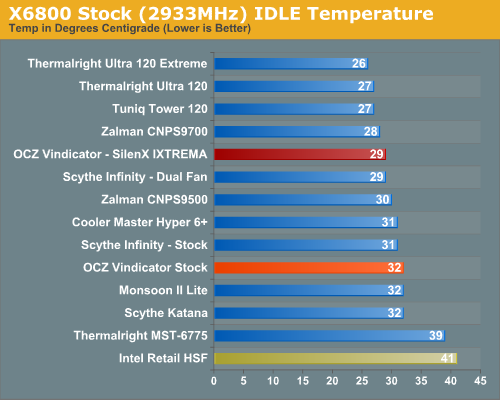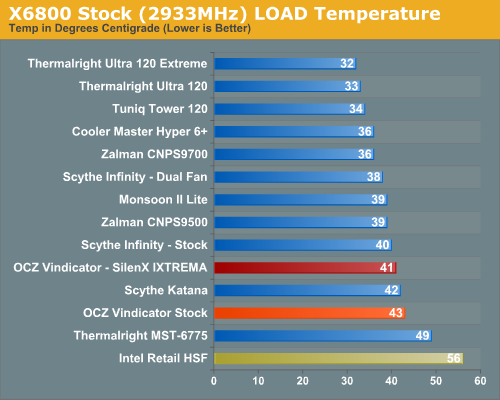OCZ Vindicator: Heatpipe Tower Cooling from OCZ
by Wesley Fink on April 5, 2007 4:00 AM EST- Posted in
- Cases/Cooling/PSUs
Cooling at Stock Speed
Some users will never overclock their CPU, but they still want to run the coolest CPU temperatures possible to enhance stability and extend CPU life. The OCZ Vindicator kit includes a moderate output low noise 120mm fan. We also tested the Vindicator with the 120mm SilenX IXTREMA 120 fan.

With the stock Vindicator fan the end user does get silence, but the cost is cooling among the poorest of the heatpipe towers tested at AnandTech. As soon as the switch is made to the SilenX fan you can see this cooler is starved for airflow with the stock fan. Idle temps with the SilenX drop to 29C, which is among the top tier of measured performance at stock idle in our cooler reviews
It is more difficult to effectively simulate a computer being stressed by all of the conditions it might be exposed to in different operating environments. For most home users CPU power is most taxed with contemporary gaming. Therefore our stress test simulates running a demanding contemporary game.
The Far Cry River demo is looped for 30 minutes and the CPU temperature is captured at 4 second intervals with the NVIDIA monitor "logging" option. The highest temperature during the stress test is then reported. Momentary spikes are ignored, as we report a sustained high-level temp that you would expect to find in this recording configuration.
Cooling efficiency of the OCZ Vindicator was tested under load conditions with both the stock fan and the SilenX at stock speed. Results are compared to the Intel retail HSF and other recently tested CPU coolers.

The OCZ Vindicator under load at stock speeds reached a maximum temperature of 43C with the stock cooler. Again this was among the worst load results at stock speed among the coolers tested at AnandTech. Switching to the SilenX fan improved the load temperature to 41C. This is still not a stellar result, but it is comparable to the Scythe Infinity under the same conditions. This compared to the Tuniq at 34C, the Cooler Master Hyper 6+ and Zalman 9700 at 36C, the Thermalright Ultra 120 at 33C , and the top Ultra 120 Extreme at 32C .
Some users will never overclock their CPU, but they still want to run the coolest CPU temperatures possible to enhance stability and extend CPU life. The OCZ Vindicator kit includes a moderate output low noise 120mm fan. We also tested the Vindicator with the 120mm SilenX IXTREMA 120 fan.

With the stock Vindicator fan the end user does get silence, but the cost is cooling among the poorest of the heatpipe towers tested at AnandTech. As soon as the switch is made to the SilenX fan you can see this cooler is starved for airflow with the stock fan. Idle temps with the SilenX drop to 29C, which is among the top tier of measured performance at stock idle in our cooler reviews
It is more difficult to effectively simulate a computer being stressed by all of the conditions it might be exposed to in different operating environments. For most home users CPU power is most taxed with contemporary gaming. Therefore our stress test simulates running a demanding contemporary game.
The Far Cry River demo is looped for 30 minutes and the CPU temperature is captured at 4 second intervals with the NVIDIA monitor "logging" option. The highest temperature during the stress test is then reported. Momentary spikes are ignored, as we report a sustained high-level temp that you would expect to find in this recording configuration.
Cooling efficiency of the OCZ Vindicator was tested under load conditions with both the stock fan and the SilenX at stock speed. Results are compared to the Intel retail HSF and other recently tested CPU coolers.

The OCZ Vindicator under load at stock speeds reached a maximum temperature of 43C with the stock cooler. Again this was among the worst load results at stock speed among the coolers tested at AnandTech. Switching to the SilenX fan improved the load temperature to 41C. This is still not a stellar result, but it is comparable to the Scythe Infinity under the same conditions. This compared to the Tuniq at 34C, the Cooler Master Hyper 6+ and Zalman 9700 at 36C, the Thermalright Ultra 120 at 33C , and the top Ultra 120 Extreme at 32C .










41 Comments
View All Comments
yyrkoon - Monday, April 9, 2007 - link
These 40 posts are a mostly 'bitches' from people who 'claim' Anandtech reviewers are 'wrong' ?In case it is not already obvious, Anandtech is an enthusiast site, which means they cater to the overclockers, and people who care about computer hardware in general, not people who can not sleep when someone drops a pin over in china . . .
Seriously, I can understand pointing out typos, and a disagreement or two on the finer points, and what not, but complaining because you think their data is incorrect, based on data given by another site(which obviously is not even in the same class of a site), is plain stupid. Do you actually know for a fact that the data from this other site is correct ? If so, how do you know ? If 30dba is what is considered a quite room, wtf does it matter if Andantech 'claims' the fan used here is 14dba or not ? Personally, I think some of you guys, are entirerly too anal, and need to learn how to socialize a tad better. something like: 'I do not think 14dba is possible on a computer fan(Correct me if I am wrong), but <insert some other point here>' probably would have worked just fine, without sounding like you are bashing the reviewers of the site.
There are many ways to say that you think the data given is incorrect, without sounding like a horses ass, and in the long run, no one is twisting your arm to come here and read the reviews. If you really, really like this other site so much, that you feel it nessisary to come here and bash the Anandtech crew, I think we all can agree, it would be a much better place here, if you just stayed away.
Affectionate-Bed-980 - Friday, April 6, 2007 - link
Real world testing is great, but isnt this how someone's Core 2 duo article got FLAMED to death because there was a bottleneck?When we test fans, yea it's great to know that 14 dB fan won't do jack in my system when my PSU is running around 30.
Just like it doesn't matter that my sticks of RAM can clock to DDR600 because my Opteron 170 won't let me go past 250 HTT anyways, so I can only go to DDR500 anyways unlesss I really want a lower multiplier.
There are limits left and right, but EVERYONE wants to know the specifications and capabilities of THE PRODUCT IN INTEREST. This is similar to high school science or junior high or whenever you learn that in experimenets, your goal is to isolate one variable and test it.
I don't give a damn that my PSU is going to be loud. What if i used a fanless system? There are people out there who want to know how loud this damn SilenX fan is, and we wnat to know how loud it REALLY IS compared to the specs.
I'm tired of hearing how really only REAL WORLD performance matters. Give us the LAB numbers and then give us how real world performance might come into play.
As an engineer, when you look up materials properties like strength tests, hardness numbers, stress concentration data, it's ALL lab samples that are perfect. It's your job when you choose a material to use in applications to understand the real world implications.
Similarly, it's your job to understand that when you pick up a 14 dB fan, that your PSU may still be louder and that your system may not be that quiet.
DrMrLordX - Friday, April 6, 2007 - link
The "product in interest" is the HSF itself, not the add-on fan. The whole point of adding the fan, I suppose, was to show that the included fan produced as much (or more) noise while yielding significantly inferior results.The HSF still wasn't that great even with the add-on fan, so it's all rather academic to me. Unless this HSF sells for a very low price, I can see no reason to shell out ~$50-$60 for it + the SilenX fan when you can get a cooler that performs better for the same amount of money. Choose wisely, and you might even get one that's just as silent.
People need to stop making a mountain out of a mole-hill here. Geez.
strikeback03 - Friday, April 6, 2007 - link
then go read over at SPCR. They try and tell you how loud each component is, Anandtech tries to tell you whether it matters. no point in repeating tests easily available elsewhere.Affectionate-Bed-980 - Saturday, April 7, 2007 - link
Yes I know that. It's great going to SPCR to see good sound testing, but it's just a PITA that I have to hit up like 10 different hardware sites to get information.poohbear - Thursday, April 5, 2007 - link
wow socket A support for this cooler?!? it prolly costs more than the socket A cpu and mobo put together! lolWesley Fink - Thursday, April 5, 2007 - link
Socket A is not supported.bob4432 - Thursday, April 5, 2007 - link
skt 468...sh!t, i missed a whole family of cpus... :(Wesley Fink - Thursday, April 5, 2007 - link
Typo corrected :)scott967 - Thursday, April 5, 2007 - link
I like the noise testing, but at least in my systems I have a problem with hi freq fan whine. It would be nice in your fan review if you could get a spectrum analyzer and look for noise spikes as well as average dBa.